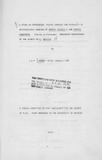| dc.contributor.author | Owuor, JB | |
| dc.date.accessioned | 2013-05-25T10:25:35Z | |
| dc.date.available | 2013-05-25T10:25:35Z | |
| dc.date.issued | 1979 | |
| dc.identifier.citation | A thesis submitted in fulfilment for the Degree of Master of Science in the University of Nairobi. Department of Crop Science. Faculty of Agriculture. University of Nairobi. | en |
| dc.identifier.uri | http://erepository.uonbi.ac.ke:8080/xmlui/handle/123456789/25676 | |
| dc.description.abstract | A breeding programme is in progress at the Coffee
Research Station. Ruiru with a main objective being to develop
Coffea arabica cultivars resistant to coffee berry disease
caused by Colletotrichum coffeanum Noack and coffee rust
Hemlleia vastatrix B. & Br. A number of C. arabica varieties
have been used as progenitors of disease resistance. At the
same time interspecific hybrids of £. arabica and tetraploid
£. canephora called arabusta were also made to enable introgressian
of disease resistance and vigour of £. canephora. into
cultivars of C. arabica. This report summarises the results of
a comparative study on the morphology. ~loral biology and fertility
of arabusta its parent species and backcrosses of the hybrid to
C. arabica.
Arabusta plants could be classified into two phenotypic
classes distinctive for leaf size and canopy shape. Notwithstanding.
all arabusta plants were found to resemble other tetraploid plants
in stomata density. length of the guard cells. pollen diameter and
leaf length to width ratio. From observations on mitotic chromosomes
in root tips and meiotic chromosomes in pollen mother cells.
the indication from morphological characters that the two arabusta
phenotypes were not the result of chromosome number differences was
confirmed.
The results from a number of growth components showed
arabusta of phenotype FI R to have remarkable vigour.
(iv)
Fertility was estimated from pollen stainability, in vitro
pollen germination, % used ovules and fruit set from crosses as
well as open pollination. The results showed in each case that
arabusta had a very low fertility; 6.0 ~ 0.9% on pollen germination
compared to 72.0 ~ 2.6% in C. arabica cv. SL 28 both tested
under the same conditions. A large range in fertility was
observed within arabusta families indicating effectiveness of
selection for fertility within this material. An important
result with regard to introgression of disease resistance and
vigaur of £. canephora into.£. arabica cultivars is that fertility
is restored to almost normal levels. already in the second backcross
of the arabusta to C. arabica.
It was observed that arabusta produced normal flowers with
very few star flowers unlike other coffee interspecific hybrids.
The results also showed that artificial doubling of the number of
chromosomes in £. canephora was of no consequence on self incompatibility
in this species. It is suggested that the genetic Isystem
.for self incompatibility in £. canephora may probably not be
monofactorial gametophytic as previously reported.
It was found that at Ruiru. meiosis in pollen mother cells
could be studied in flower bud samples drawn between 42 - 48 hours
after breaking bud dormancy.
From an analysis of a number of meiotic components which
included metaphase I chromosome associations. distribution of the
chromosomes over the anaphase I poles and the frequency of microspores
formed per tetrad, it was shown that the reduced fertility
(v)
of the arabusta is mostly an expression of their subnormal
meiosis. More precisely. the results indicated that a poorly
regulated meiosis could be responsible.
Some practical implications of these results with regard
to the use of arabusta in introgression of disease resistance
and vigour. as well as its possible role in robusta coffee
improvement are discussed. | en |
| dc.language.iso | en | en |
| dc.title | A study on morphology, floral biology and fertility of interspecific hybrids of coffea arabica l.and coffea canephora pierre ex froehner. including backcrosses of the hybrid to c. arabica | en |
| dc.type | Thesis | en |
| local.publisher | Plant Science & Crop Protection, University of Nairobi | en |

